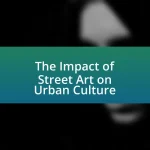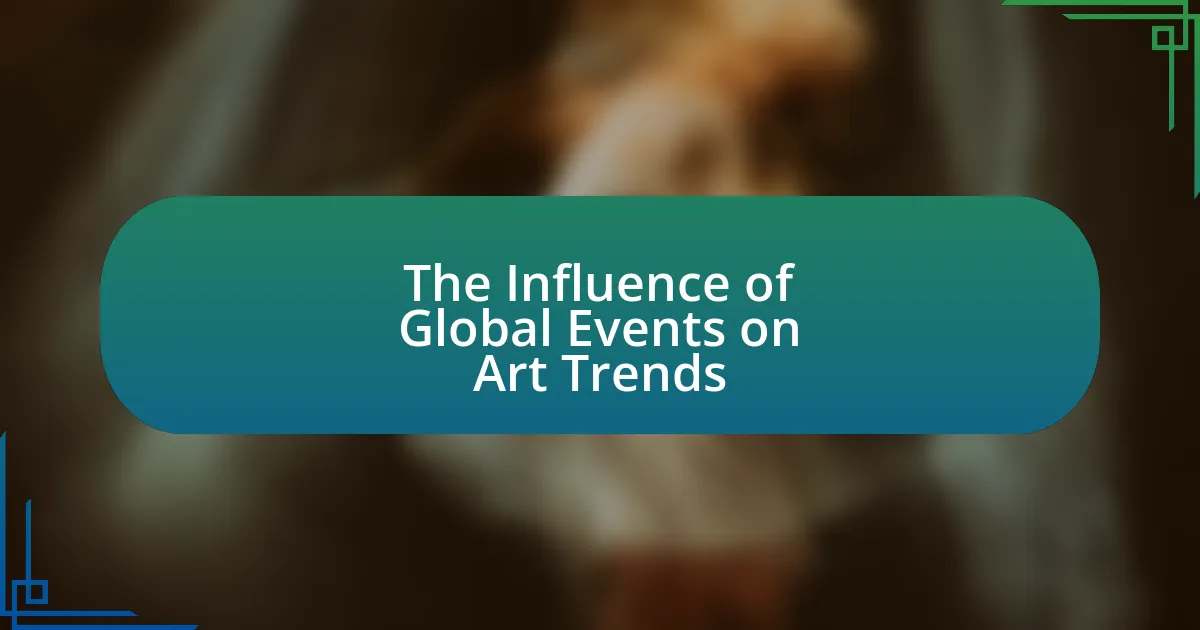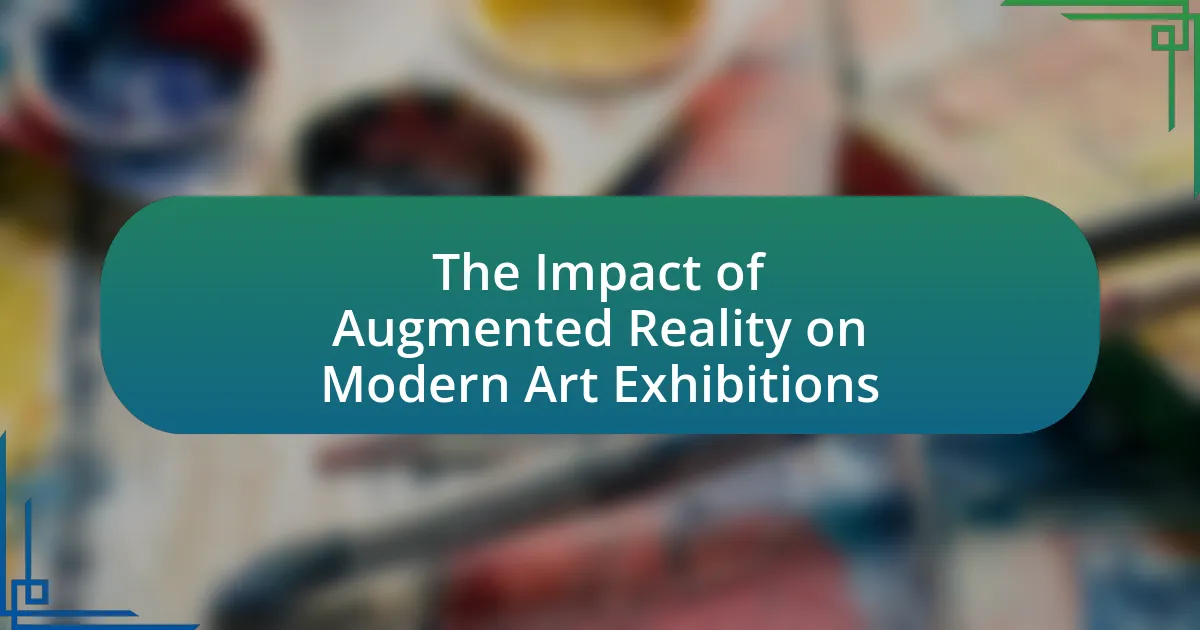Collaborative art projects are artistic endeavors where multiple individuals or groups work together to create shared artworks, emphasizing teamwork and diverse perspectives. These projects differ from traditional art forms by prioritizing collective creation over individual authorship, fostering community engagement and inclusivity. Key characteristics include collective participation, shared creativity, and the blending of various skills, which enhance social cohesion and cultural exchange. The rise of digital platforms has further facilitated collaboration across geographical boundaries, making art more accessible. Challenges such as differing artistic visions and logistical issues can arise, but effective communication and defined roles can enhance project success. Emerging themes in collaborative art include social engagement and environmental awareness, reflecting contemporary societal issues.
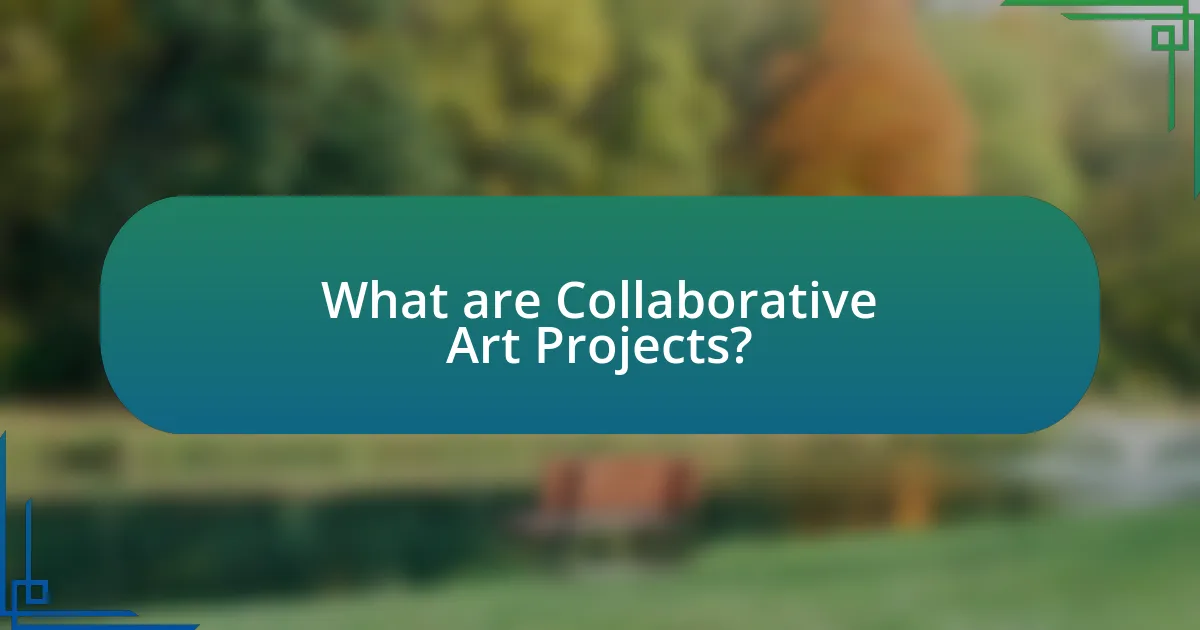
What are Collaborative Art Projects?
Collaborative art projects are artistic endeavors where multiple individuals or groups work together to create a shared piece of art. These projects often emphasize teamwork, collective creativity, and the blending of diverse perspectives, resulting in works that reflect a variety of ideas and styles. For instance, the “Inside Out Project,” initiated by artist JR, invites people worldwide to share their portraits and stories, showcasing the power of community engagement in art. Such projects have gained popularity as they foster social connections and encourage participation from a broader audience, making art more accessible and inclusive.
How do Collaborative Art Projects differ from traditional art forms?
Collaborative art projects differ from traditional art forms primarily in their emphasis on collective creation rather than individual authorship. In traditional art, the artist typically retains sole ownership and creative control over the work, while collaborative projects involve multiple participants contributing their ideas, skills, and perspectives, resulting in a shared artistic vision. This shift fosters community engagement and inclusivity, as seen in initiatives like the “The Obliteration Room” by Yayoi Kusama, where visitors actively participate in transforming a blank space into a vibrant artwork. Such projects often challenge conventional notions of authorship and encourage dialogue among diverse groups, reflecting contemporary social dynamics.
What are the key characteristics of Collaborative Art Projects?
Collaborative art projects are characterized by collective participation, shared creativity, and diverse perspectives. These projects involve multiple artists or community members working together towards a common artistic goal, fostering a sense of community and inclusivity. The collaborative process often leads to innovative outcomes that reflect the varied backgrounds and skills of the participants. Research indicates that such projects can enhance social cohesion and promote cultural exchange, as seen in initiatives like the “Community Art Project” in Chicago, which brought together artists from different neighborhoods to create a mural that represents their shared experiences.
How do artists collaborate in these projects?
Artists collaborate in these projects through various methods such as joint creation, sharing resources, and combining diverse skills. They often engage in brainstorming sessions to generate ideas, establish roles based on individual strengths, and utilize digital platforms for communication and coordination. For instance, a study by the University of California found that collaborative art projects enhance creativity and innovation by allowing artists to merge different perspectives and techniques, leading to unique outcomes that reflect a collective vision.
Why are Collaborative Art Projects gaining popularity?
Collaborative art projects are gaining popularity due to their ability to foster community engagement and creativity. These projects encourage diverse groups of individuals to come together, share ideas, and create art collectively, which enhances social interaction and cultural exchange. Research indicates that participation in collaborative art initiatives can lead to increased feelings of belonging and empowerment among participants, as seen in studies conducted by the National Endowment for the Arts, which highlight the positive impact of community-based art on social cohesion. Additionally, the rise of digital platforms has made it easier for artists to collaborate across geographical boundaries, further contributing to the trend.
What social factors contribute to the rise of Collaborative Art Projects?
Social factors contributing to the rise of Collaborative Art Projects include increased community engagement, the democratization of art, and the influence of social media. Community engagement fosters collaboration among diverse groups, allowing individuals to share their perspectives and skills, which enhances creativity and inclusivity. The democratization of art has made it accessible to a broader audience, encouraging participation from non-traditional artists and communities. Additionally, social media platforms facilitate the sharing and promotion of collaborative projects, enabling artists to connect with wider audiences and collaborate across geographical boundaries. These factors collectively drive the growth and popularity of Collaborative Art Projects.
How does technology influence the popularity of Collaborative Art Projects?
Technology significantly enhances the popularity of Collaborative Art Projects by facilitating communication, accessibility, and engagement among artists and audiences. Digital platforms enable artists from diverse backgrounds to collaborate in real-time, breaking geographical barriers and fostering a global community. For instance, tools like social media and collaborative software allow for the sharing of ideas and resources, which can lead to innovative artistic expressions. Additionally, technology provides wider access to art through online exhibitions and virtual reality experiences, attracting larger audiences. According to a report by the National Endowment for the Arts, online art projects have seen a 50% increase in participation over the past five years, illustrating how technology directly correlates with the growth of collaborative art initiatives.
What are the benefits of participating in Collaborative Art Projects?
Participating in Collaborative Art Projects enhances creativity, fosters community engagement, and promotes skill development. These projects allow individuals to share diverse perspectives, leading to innovative artistic expressions that may not emerge in solitary work. Research indicates that collaboration can improve problem-solving abilities and increase motivation, as participants feel a sense of belonging and shared purpose. Additionally, studies show that collaborative efforts can lead to higher-quality outcomes, as the pooling of talents and ideas often results in more refined and impactful art.
How do Collaborative Art Projects foster community engagement?
Collaborative art projects foster community engagement by creating shared experiences that encourage participation and dialogue among diverse groups. These projects often involve community members in the artistic process, allowing individuals to contribute their perspectives and skills, which strengthens social bonds. For instance, a study by the National Endowment for the Arts found that community-based art initiatives lead to increased social cohesion and a sense of belonging among participants. By bringing people together to work towards a common goal, collaborative art projects not only enhance individual creativity but also promote collective identity and community pride.
What skills can participants develop through Collaborative Art Projects?
Participants can develop skills such as teamwork, communication, creativity, and problem-solving through Collaborative Art Projects. Teamwork is enhanced as individuals must work together towards a common artistic goal, fostering collaboration and mutual support. Communication skills improve as participants share ideas, provide feedback, and negotiate roles within the project. Creativity is stimulated as diverse perspectives and techniques are combined, leading to innovative artistic expressions. Problem-solving skills are cultivated as participants navigate challenges and find solutions collectively, reinforcing adaptability and critical thinking. These skills are essential in both artistic and professional contexts, demonstrating the multifaceted benefits of engaging in collaborative art initiatives.
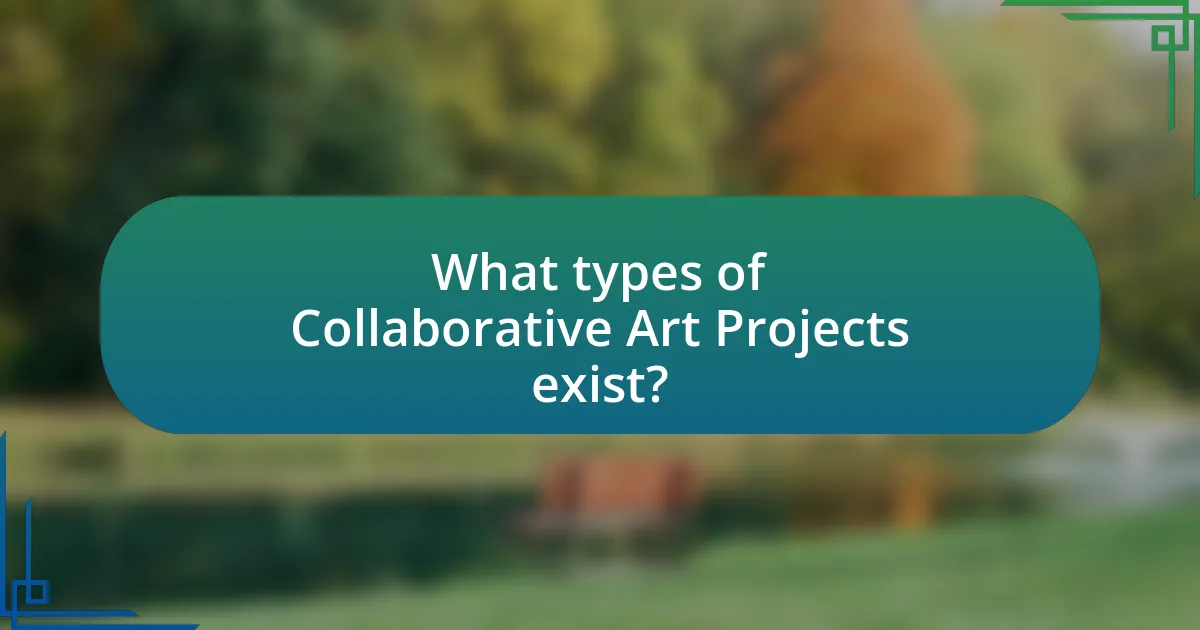
What types of Collaborative Art Projects exist?
Collaborative art projects can be categorized into several types, including community murals, participatory installations, co-created performances, and online collaborative platforms. Community murals involve local artists and residents working together to create large-scale artworks that reflect the community’s identity. Participatory installations invite audience interaction, allowing participants to contribute to the artwork’s evolution. Co-created performances often involve multiple artists collaborating in real-time, blending various art forms. Online collaborative platforms enable artists from different locations to work together digitally, sharing ideas and creations. These types of projects foster creativity, inclusivity, and social engagement, highlighting the importance of collaboration in the art world.
How do different mediums affect Collaborative Art Projects?
Different mediums significantly influence collaborative art projects by shaping the methods of interaction, expression, and outcome. For instance, visual mediums like painting or sculpture allow for tangible, shared experiences, fostering direct collaboration among artists. In contrast, digital mediums enable remote collaboration, allowing artists from diverse geographical locations to contribute simultaneously, which can enhance creativity through varied perspectives. Research indicates that projects utilizing mixed media often yield richer results, as they combine the strengths of various forms, such as sound, video, and traditional art, leading to innovative outcomes. This adaptability in mediums not only enhances the collaborative process but also broadens the audience’s engagement, as evidenced by the success of projects like “The Obliteration Room” by Yayoi Kusama, where participants transformed a white room into a colorful space through collective action.
What are some examples of visual Collaborative Art Projects?
Some examples of visual collaborative art projects include “The Obliteration Room” by Yayoi Kusama, where participants cover a white room with colorful dot stickers, and “The 1000 Journals Project,” which invites individuals to contribute to shared journals that travel globally. Another notable project is “Inside Out,” initiated by JR, which encourages people to share their portraits and stories through large-scale public installations. These projects exemplify how collaboration can enhance artistic expression and community engagement.
How do performance-based Collaborative Art Projects differ from visual ones?
Performance-based Collaborative Art Projects differ from visual ones primarily in their reliance on live action and audience interaction. Performance-based projects often involve real-time engagement, where the artists and participants create art through movement, sound, or drama, emphasizing the ephemeral nature of the experience. In contrast, visual Collaborative Art Projects focus on static forms such as paintings, sculptures, or installations, which can be observed and appreciated over time without the need for live participation. This distinction highlights that performance art prioritizes the process and experience of creation, while visual art emphasizes the final product and its aesthetic value.
What role do institutions play in Collaborative Art Projects?
Institutions play a crucial role in collaborative art projects by providing resources, infrastructure, and legitimacy that facilitate artistic collaboration. They often serve as platforms for artists to connect, share ideas, and access funding, which is essential for the success of these projects. For instance, museums and galleries frequently host collaborative exhibitions, allowing artists to showcase their work in a professional setting, thereby enhancing visibility and audience engagement. Additionally, institutions can offer educational programs and workshops that encourage community participation, fostering a collaborative spirit among diverse groups. This support not only enriches the artistic process but also strengthens community ties, as evidenced by initiatives like the Tate Modern’s “Tate Exchange,” which invites public participation in art-making activities, demonstrating the impact of institutional involvement in collaborative art.
How do galleries and museums support Collaborative Art Projects?
Galleries and museums support collaborative art projects by providing funding, space, and resources for artists to work together. These institutions often allocate grants specifically for collaborative initiatives, enabling artists to combine their skills and ideas. Additionally, galleries and museums offer exhibition space that showcases the outcomes of these projects, increasing visibility and audience engagement. For instance, the Museum of Modern Art in New York has hosted collaborative exhibitions that highlight the work of multiple artists, fostering a community of creativity and innovation. This support not only enhances the artistic landscape but also encourages public participation and dialogue around contemporary art practices.
What impact do educational institutions have on Collaborative Art Projects?
Educational institutions significantly enhance Collaborative Art Projects by providing resources, fostering creativity, and facilitating interdisciplinary collaboration. These institutions often offer access to funding, materials, and spaces conducive to artistic expression, which are crucial for the success of such projects. For instance, universities frequently host workshops and exhibitions that encourage student participation and community engagement, thereby amplifying the reach and impact of collaborative art initiatives. Additionally, research conducted by the National Endowment for the Arts indicates that educational settings promote teamwork and innovation, essential components in the development of collaborative art, as they bring together diverse perspectives and skill sets.

What challenges do Collaborative Art Projects face?
Collaborative art projects face challenges such as differing artistic visions, communication barriers, and logistical coordination. Differing artistic visions can lead to conflicts among participants, as each artist may have unique ideas about the project’s direction. Communication barriers often arise from varying levels of experience and artistic language, which can hinder effective collaboration. Logistical coordination, including scheduling, resource allocation, and space management, poses additional difficulties, as multiple artists must align their efforts to achieve a cohesive outcome. These challenges can impact the overall success and harmony of the collaborative endeavor.
How do logistical issues affect the success of Collaborative Art Projects?
Logistical issues significantly hinder the success of Collaborative Art Projects by creating barriers to effective communication, resource allocation, and project coordination. For instance, inadequate planning can lead to misalignment among artists regarding timelines and responsibilities, resulting in delays and frustration. A study by the National Endowment for the Arts found that 70% of collaborative projects faced challenges related to scheduling conflicts and resource sharing, which directly impacted their outcomes. Furthermore, logistical complications such as transportation of materials and venue accessibility can limit participation and engagement, ultimately affecting the quality and reach of the artistic work produced.
What are common communication barriers in Collaborative Art Projects?
Common communication barriers in collaborative art projects include differing artistic visions, language differences, and lack of clarity in roles and responsibilities. Differing artistic visions can lead to conflicts as participants may have unique interpretations and expectations for the project. Language differences can hinder effective communication, especially in diverse teams, making it challenging to convey ideas and feedback. Additionally, a lack of clarity in roles and responsibilities can result in misunderstandings about who is accountable for specific tasks, leading to confusion and inefficiency. These barriers can significantly impact the collaborative process and the overall success of the project.
How can conflicts among collaborators be resolved?
Conflicts among collaborators can be resolved through open communication and mediation. Establishing a safe environment for dialogue allows collaborators to express their concerns and perspectives, which is essential for understanding differing viewpoints. Mediation by a neutral third party can facilitate this process, helping to clarify misunderstandings and guide the collaborators toward a mutually acceptable solution. Research indicates that effective conflict resolution strategies, such as active listening and compromise, can significantly improve team dynamics and project outcomes, as evidenced by studies in organizational behavior that highlight the importance of collaboration in creative settings.
What are the future trends in Collaborative Art Projects?
Future trends in collaborative art projects include increased integration of technology, such as virtual reality and artificial intelligence, to enhance creative collaboration. Artists are increasingly utilizing digital platforms to connect with global audiences and co-create in real-time, breaking geographical barriers. For instance, projects like “The Obliteration Room” by Yayoi Kusama demonstrate how interactive installations can engage participants in a shared artistic experience. Additionally, there is a growing emphasis on social and environmental themes, with artists collaborating to address issues like climate change and social justice, as seen in initiatives like “The Ocean Cleanup.” These trends reflect a shift towards inclusivity and community engagement in the art world, fostering diverse voices and perspectives.
How might technology shape the evolution of Collaborative Art Projects?
Technology will significantly shape the evolution of Collaborative Art Projects by enabling real-time collaboration across geographical boundaries. Digital platforms and tools, such as virtual reality and online collaborative software, allow artists from different locations to work together seamlessly, fostering diverse perspectives and innovative ideas. For instance, projects like “The Obliteration Room” by Yayoi Kusama utilized digital technology to engage participants worldwide, demonstrating how technology can enhance participation and creativity in collaborative art. This integration of technology not only broadens the reach of collaborative projects but also transforms the way artists interact, share, and create, ultimately leading to a richer and more inclusive artistic landscape.
What emerging themes are being explored in Collaborative Art Projects?
Emerging themes in Collaborative Art Projects include social engagement, community building, and environmental awareness. These themes reflect a shift towards inclusivity and collective participation, where artists and communities collaborate to address societal issues. For instance, projects like “The People’s Choice” by the artist group Superflex emphasize democratic participation and community decision-making in art. Additionally, initiatives such as “The Ocean Cleanup” highlight environmental concerns, showcasing how collaborative efforts can mobilize communities towards sustainability. These themes are increasingly relevant as they resonate with contemporary social movements and the need for collective action in addressing global challenges.
What best practices should artists follow in Collaborative Art Projects?
Artists should prioritize clear communication and defined roles in collaborative art projects. Establishing open dialogue ensures that all participants understand the project’s vision and their individual contributions. Additionally, setting specific goals and deadlines helps maintain focus and accountability among collaborators. Research indicates that projects with well-defined roles and responsibilities lead to higher satisfaction and productivity among team members. For instance, a study published in the Journal of Creative Behavior found that collaborative projects with clear communication protocols resulted in a 30% increase in overall project success rates.
How can artists effectively communicate and collaborate with each other?
Artists can effectively communicate and collaborate with each other by utilizing clear communication channels, establishing mutual goals, and engaging in regular feedback sessions. Clear communication channels, such as digital platforms or in-person meetings, facilitate the exchange of ideas and ensure that all participants are on the same page. Establishing mutual goals aligns the artists’ visions and helps to create a cohesive project direction. Regular feedback sessions allow artists to discuss progress, address challenges, and refine their contributions, fostering a collaborative environment. Research indicates that successful collaborative projects often involve structured communication and defined roles, which enhance productivity and creativity among artists.
What strategies can enhance the impact of Collaborative Art Projects?
To enhance the impact of Collaborative Art Projects, fostering strong communication among participants is essential. Effective communication ensures that all voices are heard, leading to a more inclusive and diverse creative process. Research indicates that projects with clear communication strategies, such as regular meetings and feedback sessions, result in higher participant satisfaction and better artistic outcomes. Additionally, establishing a shared vision and goals among collaborators can unify efforts and enhance the project’s overall coherence. Studies show that projects with defined objectives tend to engage audiences more effectively, as they resonate with a clear message. Furthermore, incorporating community involvement can amplify the project’s reach and relevance, as seen in initiatives that actively engage local populations, leading to increased visibility and support.

